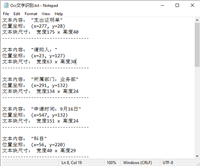一、什么是lru
lru(least recently used,最近最少使用)是一种常用的缓存淘汰算法,用于在缓存空间不足时决定哪些数据应该被移除。
核心思想
如果一个数据最近被访问过,那么它将来被访问的概率也更高。因此,当缓存空间不足时,应该优先淘汰最久未被访问的数据。
工作原理
访问数据时
- 如果数据在缓存中(缓存命中),则将该数据标记为"最近使用",并移动到缓存的最前面(或最后面,取决于实现)。
- 如果数据不在缓存中(缓存未命中),则从原始数据源加载。
缓存满时
- 需要插入新数据时,移除最久未被访问的数据(即lru数据),
- 然后插入新数据到最新位置。
主要特性
- 固定容量:限制缓存大小,防止内存无限增长。
- 自动淘汰机制:当缓存满时,移除最旧的条目。
- 快速访问:
get()和put()操作的时间复杂度均为 o(1)。 - 保持访问顺序:每次访问或更新缓存条目时,会将其移至最新位置。
二、核心实现
1. 数据结构
使用 ordereddict 存储键值对,并维护访问顺序:
- 最新访问的条目 位于字典的末尾。
- 最久未访问的条目 位于字典的开头。
2. 关键方法
__init__(self, capacity)
初始化缓存,设置最大容量。
- 参数:
capacity(int):缓存的最大条目数。 - 示例:
cache = latestcache(1000) # 最大存储 1000 个条目
get(self, key)
获取缓存中的值,如果不存在则返回 none。
- 参数:
key:要查询的键。 - 返回值: 如果存在,返回对应的值;否则返回
none。 - 示例:
value = cache.get("some_key")
put(self, key, value)
向缓存中添加或更新键值对。
- 参数:
key:要存储的键;value:要存储的值。 - 行为: 如果
key已存在,更新其值并移至最新位置; 如果缓存已满,移除最旧的条目。 - 示例:
cache.put("some_key", "some_value")
三、使用示例
1. 基本用法
from collections import ordereddict
class latestcache:
def __init__(self, capacity):
self.cache = ordereddict()
self.capacity = capacity
def get(self, key):
if key not in self.cache:
return none
self.cache.move_to_end(key) # 移至最新位置
return self.cache[key]
def put(self, key, value):
if key in self.cache:
self.cache.move_to_end(key) # 更新时移至最新位置
self.cache[key] = value
if len(self.cache) > self.capacity:
self.cache.popitem(last=false) # 移除最旧的条目
# 初始化缓存
cache = latestcache(3)
# 添加数据
cache.put("a", 1)
cache.put("b", 2)
cache.put("c", 3)
# 查询数据
print(cache.get("a")) # 输出: 1
# 缓存满时自动淘汰
cache.put("d", 4) # 淘汰最久未访问的键 "b"
print(cache.get("b")) # 输出: none(已被淘汰)
2. 适用场景
- 高频读取、低频写入:如配置缓存、静态数据缓存。
- 减少重复计算:如函数结果缓存。
- 优化数据库/api 查询:缓存热点数据,减少 io 开销。
四、优化建议
1. 线程安全改进
当前实现 非线程安全,多线程环境下可能导致数据竞争。可引入 threading.rlock 加锁:
from threading import rlock
class latestcache:
def __init__(self, capacity):
self._lock = rlock()
self.cache = ordereddict()
self.capacity = capacity
def get(self, key):
with self._lock:
if key not in self.cache:
return none
self.cache.move_to_end(key)
return self.cache[key]
def put(self, key, value):
with self._lock:
if key in self.cache:
self.cache.move_to_end(key)
self.cache[key] = value
if len(self.cache) > self.capacity:
self.cache.popitem(last=false)
2. 缓存命中率统计
增加 hits 和 misses 统计,评估缓存效率:
- hits: 记录成功从缓存中获取数据的次数
- misses: 记录未能从缓存中获取数据的次数
- cache: 使用ordereddict实现的缓存存储,保持键的插入顺序
- capacity: 缓存的最大容量
from threading import rlock
from collections import ordereddict
class latestcache:
def __init__(self, capacity):
self._lock = rlock()
self.hits = 0
self.misses = 0
self.cache = ordereddict()
self.capacity = capacity
def get(self, key):
with self._lock:
if key in self.cache:
self.hits += 1
self.cache.move_to_end(key)
return self.cache[key]
self.misses += 1
return none
def put(self, key, value):
with self._lock:
if key in self.cache:
self.cache.move_to_end(key)
self.cache[key] = value
if len(self.cache) > self.capacity:
self.cache.popitem(last=false)
def hit_rate(self):
with self._lock:
total = self.hits + self.misses
return (self.hits / total) if total > 0 else 0.0
# 初始化缓存
cache = latestcache(3)
# 添加数据
cache.put("a", 1)
cache.put("b", 2)
cache.put("c", 3)
# 查询数据
print(cache.get("a")) # 命中,输出: 1
print(cache.get("b")) # 命中,输出: 2
print(cache.get("a")) # 命中,输出: 1
print(cache.get("x")) # 未命中,输出: none
# 缓存满时自动淘汰
cache.put("d", 4) # 淘汰最久未访问的键 "c"
print(cache.get("c")) # 未命中(已被淘汰),输出: none
# 查看命中率统计
print(f"命中次数: {cache.hits}") # 输出: 3 (aba)
print(f"未命中次数: {cache.misses}") # 输出: 2 (xc)
print(f"命中率: {cache.hit_rate():.2%}") # 输出: 60.00% (3命中/(3命中+2未命中))
3. 支持 ttl
ttl(time to live)是数据在缓存中存活的生存时间,过期后自动失效。
from collections import ordereddict
import time
import random
class latestcache:
def __init__(self, capacity):
self.cache = ordereddict()
self.capacity = capacity
def get(self, key):
if key not in self.cache:
return none
value, expire_time = self.cache[key]
if expire_time and time.time() > expire_time:
del self.cache[key] # 自动清理过期数据
return none
self.cache.move_to_end(key) # 更新为最近使用
return value
def put(self, key, value, ttl=none):
expire_time = time.time() + ttl if ttl else none
if key in self.cache:
self.cache.move_to_end(key)
self.cache[key] = (value, expire_time)
if len(self.cache) > self.capacity:
self.cache.popitem(last=false) # 移除最久未使用的
# 初始化缓存(容量为3)
cache = latestcache(3)
# 添加数据(带ttl和不带ttl的混合)
cache.put("a", 1, ttl=2) # 2秒后过期
cache.put("b", 2) # 永不过期
cache.put("c", 3, ttl=4) # 4秒后过期
# 立即查询(全部命中)
print(f"初始查询: a={cache.get('a')}, b={cache.get('b')}, c={cache.get('c')}")
# 输出: 初始查询: a=1, b=2, c=3
# 模拟2秒后('a'已过期)
print("等待2秒后...")
time.sleep(2)
print(f"查询: a={cache.get('a')}, b={cache.get('b')}, c={cache.get('c')}")
# 输出: 查询: a=none , b=2, c=3
五、总结
1. 优点
- 简单高效:基于
ordereddict,get()和put()均为 o(1) 时间复杂度。 - 自动淘汰:lru 策略防止内存无限增长。
- 易于扩展:可增加 ttl、线程安全、命中统计等功能。
2. 适用场景
- web 应用:缓存 api 响应、数据库查询结果。
- 计算密集型任务:缓存中间计算结果,避免重复计算。
- 配置管理:缓存频繁读取的配置数据。
3. 不适用场景
- 强一致性要求:缓存可能导致数据短暂不一致,如缓存更新延迟、缓存失效策略、分布式环境同步等。
- 超大数据集:单机内存有限,可改用 redis 等分布式缓存。
以上为个人经验,希望能给大家一个参考,也希望大家多多支持代码网。







发表评论